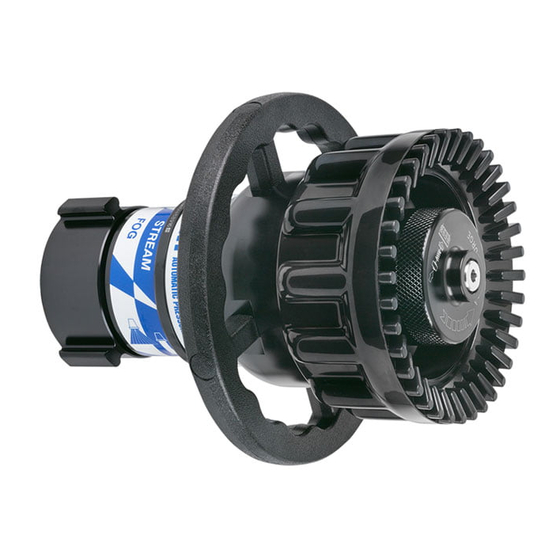Table of Contents
Advertisement
Quick Links
MASTER, MONSOON & TYPHOON
INSTRUCTIONS FOR SAFE OPERATION AND MAINTENANCE
WARNING
©Copyright Task Force Tips, Inc. 1999
MANUAL: Deluge Nozzles
With Automatic Pressure Control
Read instruction manual before use. Operation of this device without
understanding the manual and receiving proper training is a misuse of this
equipment. A person who has not read and understood all operating and safety
instructions is not qualified to operate the Master, Monsoon or Typhoon nozzle.
This instruction manual is intended to familiarize firefighters and maintenance
personnel with the operation, servicing and safety procedures associated with
the Master, Monsoon and Typhoon firefighting nozzles.
This manual should be kept available to all operating and maintenance
personnel.
2300 - 15000 LPM @ 5.5 - 8.3 BAR (550 - 830 KPA)
MASTER
150 - 1250 GPM @ 100 PSI
600 - 4700 LPM @ 7 BAR (700 KPA)
MONSOON
300 - 2000 GPM @ 100 PSI
1100 - 7500 LPM @ 7 BAR (700 KPA)
TYPHOON
600 - 4000 GPM @ 80 - 120 PSI
TASK FORCE TIPS, Inc.
800-348-2686 • www.tft.com
LIM-030 November 22, 1999 Rev 1
Advertisement
Table of Contents

Subscribe to Our Youtube Channel
Summary of Contents for Task Force Tips MASTER
- Page 1 A person who has not read and understood all operating and safety instructions is not qualified to operate the Master, Monsoon or Typhoon nozzle. This instruction manual is intended to familiarize firefighters and maintenance personnel with the operation, servicing and safety procedures associated with the Master, Monsoon and Typhoon firefighting nozzles.
-
Page 2: Table Of Contents
HYDRAULIC INSTALLATION ELECTRIC INSTALLATION PATTERN CONTROL USE WITH FOAM 2.6.1 FOAMJET LX WITH MASTER NOZZLE AUTOMATIC NOZZLE OPERATION FLOW CHARACTERISTICS OF MASTER AND MONSOON FLOW CHARACTERISTICS OF TYPHOON DETERMINING FLOW WITH PRE-PIPED MONITORS STREAM TRAJECTORY DATA FLUSHING DEBRIS MAINTENANCE WARRANTY 1.0 MEANING OF SIGNAL WORDS... -
Page 3: General Information
2.0 GENERAL INFORMATION The Task Force Tips Master, Monsoon and Typhoon nozzles are automatic pressure control deluge nozzles. These automatic nozzles operate by sensing the pressure at the nozzle's inlet and adjusting the discharge opening to maintain a constant pressure throughout the flow range of the nozzle. While flowing, the stream pattern can be varied from wide fog to straight stream. -
Page 4: Use With Salt Water
Fig 1D Stream Shaper moved remotely by electricity (12-24 volts) Fig 1E Stream Shaper moved by linear (push/pull) motion from user's mechanism FIG 1 - Methods for Moving Stream Shaper ©Copyright Task Force Tips, Inc. 1999 LIM-030 November 22, 1999 Rev 1... -
Page 5: Hydraulic Installation
2.6 USE WITH FOAM The Master, Monsoon and Typhoon nozzles may be used with foam solutions. Refer to fire service training for the proper use of foam. For Class B fires, lack of foam or interruption in the foam stream can cause a break in the WARNING foam blanket and greatly increase the risk of injury or death. -
Page 6: Foamjet Lx With Master Nozzle
2.6.1 FOAMJET LX WITH MASTER NOZZLE To increase the expansion ratio, Task Force Tips "Foamjet LX" (model FJ-LX-M) may be used with the Master nozzle. This low expansion foam tube attaches and detaches quickly from the nozzle. Adjust nozzle spray pattern to give best foam quality. -
Page 7: Flow Characteristics Of Typhoon
Where: piping pressure loss constant in GPM /PSI (or LPM /BAR) in-line pressure gauge reading in PSI (or BAR) inline ©Copyright Task Force Tips, Inc. 1999 LIM-030 November 22, 1999 Rev 1... -
Page 8: Stream Trajectory Data
3.4 STREAM TRAJECTORY DATA Figures 4A and 4B give the stream trajectory for the Master, Monsoon and Typhoon nozzles at various flows. Notes on trajectory graphs: • Graphs show approximate effective stream trajectory at 30 degrees elevation in no wind conditions. - Page 9 TYPHOON, 120 PSI (8.3 BAR, 830 KPA) 3000 1700 4000 2300 CURVE FLOW REACTION 2300 3800 7600 11000 HORIZONTAL DISTANCE (FEET) 15000 1000 EXCEL\TFT\TYPHOON116 FIG 4B - Typhoon Stream Trajectory ©Copyright Task Force Tips, Inc. 1999 LIM-030 November 22, 1999 Rev 1...
-
Page 10: Flushing Debris
In the event of a blockage, it may be necessary to retreat to a safe area. RETURN SPRING PISTON PUSH ROD CYLINDER SPRAY LUBE SHAFT LUBE LUBE LUBE TFT\MASTER\MTFT_ISO FIG 5A - Master Nozzle Front End Parts ©Copyright Task Force Tips, Inc. 1999 LIM-030 November 22, 1999 Rev 1... - Page 11 FIG 5B - Monsoon Nozzle Front End Parts LUBE LUBE LUBE CONTROL POPPET SPRING SHAFT RETURN SPRING LUBE CYLINDER PISTON tft\typhoon\mt850 FIG 5C - Typhoon Nozzle Front End Parts ©Copyright Task Force Tips, Inc. 1999 LIM-030 November 22, 1999 Rev 1...
-
Page 12: Maintenance
(see figure 1). 6.0 WARRANTY Task Force Tips, Inc., 2800 East Evans Avenue, Valparaiso, Indiana 46383 ("TFT") warrants to the original purchaser of its Master, Monsoon and Typhoon series nozzles ("equipment"), and to anyone to whom it is transferred, that the equipment shall be free from defects in material and workmanship during the five (5) year period from the date of purchase.















Need help?
Do you have a question about the MASTER and is the answer not in the manual?
Questions and answers